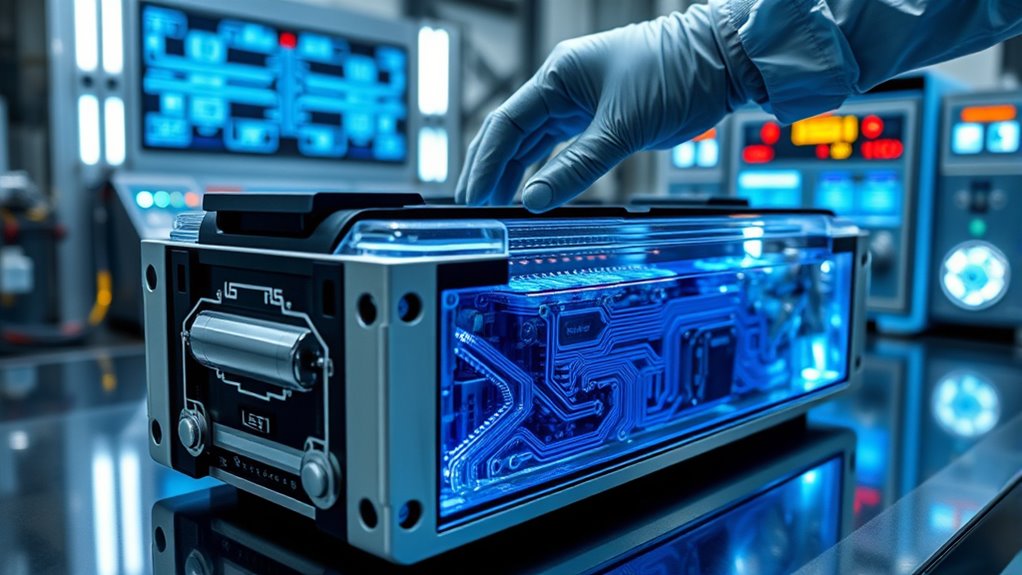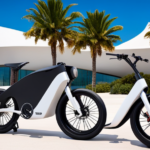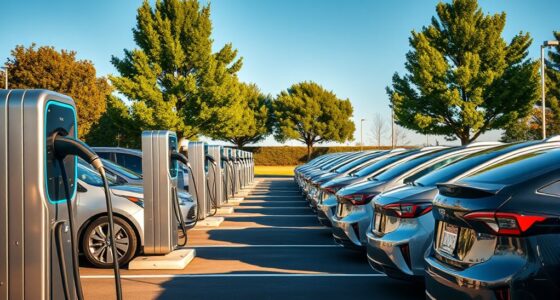Innovations in EV battery technology include advanced chemistries like solid-state, lithium-sulfur, and sodium-ion batteries, offering higher energy density, faster charging, and improved sustainability. Breakthrough designs such as cell-to-pack and bipolar architectures boost efficiency and reduce costs. Sustainable materials like recycled components and biodegradable electrodes are making batteries eco-friendly. Rapid charging solutions and wireless power transfer further enhance convenience. To learn more about these exciting developments shaping the future, keep exploring these innovative trends.
Key Takeaways
- Solid-state batteries offer higher energy density, faster charging, and improved safety by replacing liquid electrolytes with ceramics or polymers.
- Cell-to-pack and bipolar architectures increase efficiency, reduce weight, and lower costs through innovative cell integration and stacking methods.
- Lithium-sulfur and silicon anodes significantly boost energy capacity, enabling longer-range EVs and lighter battery packs.
- Rapid charging technologies like nanowire batteries and biological semiconductor chargers enable charging times under 10 minutes.
- Eco-friendly materials such as recycled critical minerals, biodegradable electrodes, and sustainable chemistries promote sustainability and cost reduction.
Advanced Chemistries Shaping the Future of EV Batteries
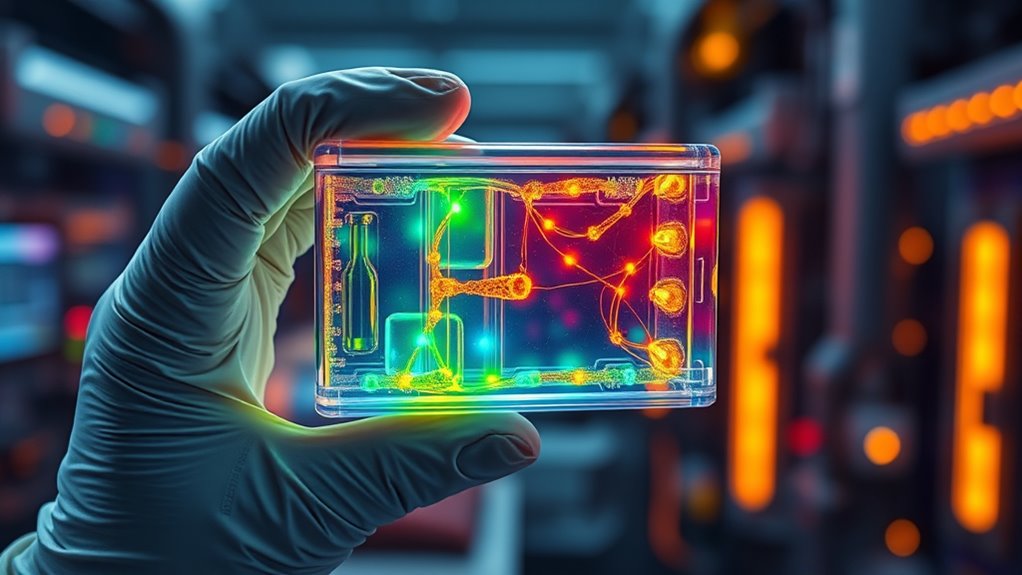
Advancements in battery chemistry are driving the future of electric vehicles by offering safer, more sustainable, and cost-effective options. Solid-state batteries, with prototypes from companies like Toyota, replace liquid electrolytes with ceramics or polymers, enabling higher energy density and faster charging while enhancing safety. Silicon anodes, capable of holding more lithium, markedly increase energy capacity and reduce battery weight, with innovators like Sila Nanotechnologies leading the way. Lithium-sulfur batteries utilize sulfur’s high capacity, offering higher energy density and safety benefits over traditional chemistries. Meanwhile, improvements in cathode materials and overall battery chemistry continue to push the limits of performance. These innovations promise longer driving ranges, quicker charging times, and safer operation—crucial for the widespread adoption of electric vehicles.
Breakthrough Technologies in Battery Design and Architecture
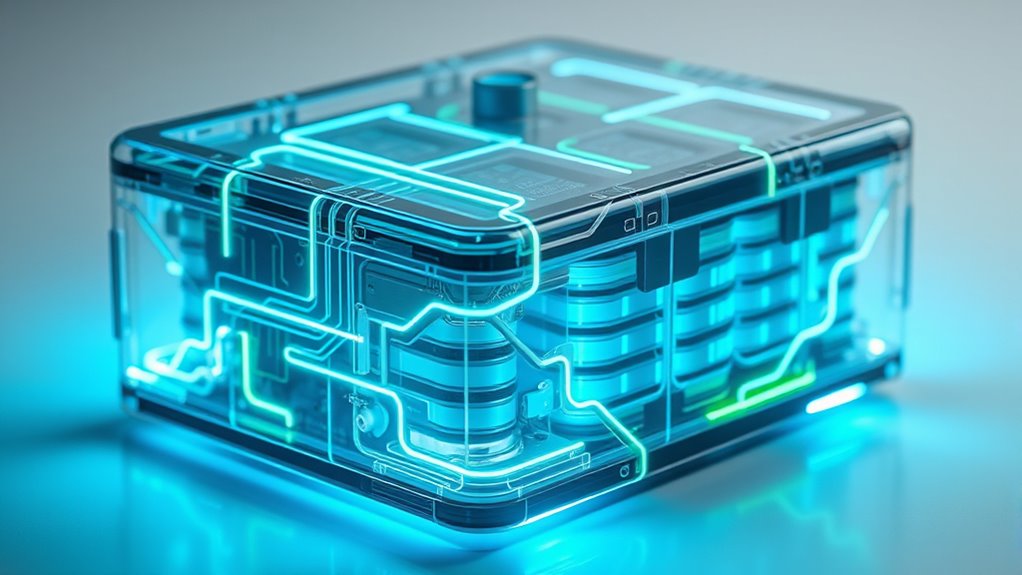
Innovations in battery design and architecture are transforming how electric vehicle batteries deliver performance and safety. Cell-to-pack technology removes modules, boosting energy density by up to 20%. Bipolar batteries stack cells with shared electrodes, increasing range by 20% and cutting costs by 40%. Dual-ion batteries enable rapid charging and higher voltages but face cycle life challenges. Incorporating silicon nanowires into electrodes can increase capacity tenfold while reducing swelling. Advanced cell architectures like pouch, cylindrical, and prismatic formats are optimized for thermal management and safety. The trustworthiness of these innovations depends on ongoing research and safety assessments. Increasing focus on data privacy and safety standards is crucial as battery systems become more sophisticated. The following table illustrates these innovations:
| Technology | Benefit | Impact |
|---|---|---|
| Cell-to-pack | Higher energy density | More range, lighter packs |
| Bipolar battery | Improved range and lower costs | Cost-effective, efficient |
| Silicon nanowires | Increased capacity, durability | Longer-lasting batteries |
Emerging Materials for Higher Performance and Sustainability
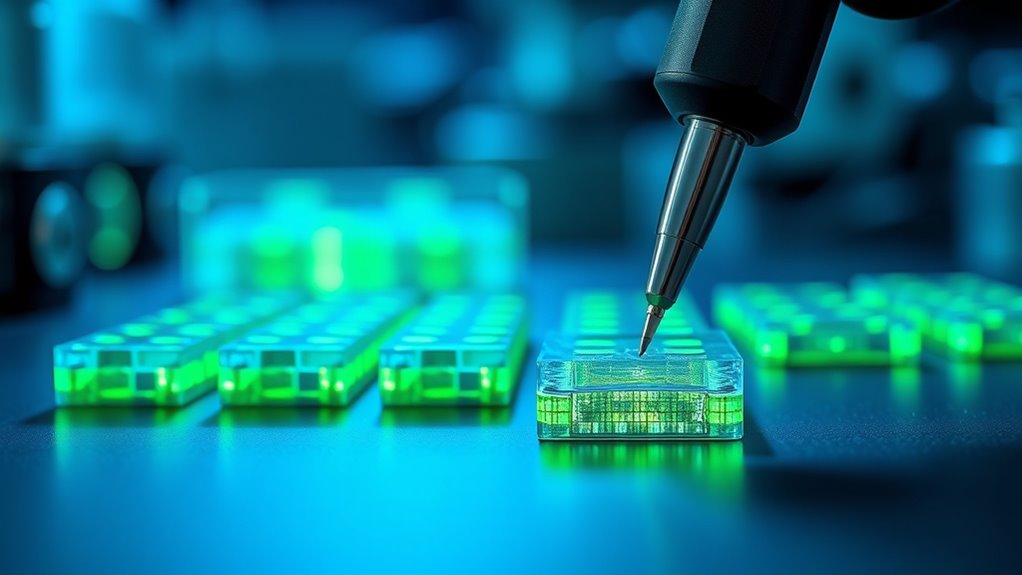
Emerging materials like silicon nanowire anodes and graphene-enhanced electrodes are pushing battery performance to new heights. Sodium-ion and lithium-sulfur chemistries offer more sustainable and cost-effective options without sacrificing too much energy density. By incorporating recycled and eco-friendly components, you can markedly improve both the performance and sustainability of EV batteries. Additionally, integrating protein-packed seeds can help in developing more sustainable, biodegradable battery components, aligning with eco-conscious advancements. Understanding the benefits of eco-friendly materials can further accelerate the adoption of greener battery technologies, especially as innovations in sound design techniques inspire new ways to visualize and communicate these advancements. Employing advanced manufacturing methods can optimize material properties and reduce waste in battery production processes. Recognizing the spiritual and emotional significance of auras can also inspire holistic approaches to sustainable innovation, fostering a mindful connection between technology and nature.
Advanced Electrode Materials
Have you ever wondered how new electrode materials can boost electric vehicle performance? Advanced electrode materials play a pivotal role in increasing energy density and longevity. Silicon nanowires in anode technology can boost capacity up to ten times compared to traditional graphite, but need coatings to manage swelling. Lithium manganese-rich cathode materials deliver higher voltage and capacity, raising overall energy density by 20-30%. Sulfur batteries leverage sulfur’s high capacity, offering longer ranges and lower costs. Copper cellulose composites are emerging as sustainable electrode materials, utilizing biomass to reduce environmental impact without sacrificing conductivity. These innovations in electrode materials are transforming EV batteries, making them more powerful, durable, and eco-friendly, and driving the future of electric mobility.
Eco-Friendly Battery Chemistries
Building on advances in electrode materials, researchers are now focusing on developing eco-friendly battery chemistries that prioritize sustainability alongside performance. LFP batteries, made from abundant and safe materials, are projected to grow considerably, emphasizing their role in sustainable chemistries. Emerging materials like silicon anodes and lithium-sulfur compounds boost energy density while reducing reliance on scarce metals, aligning with eco-friendly goals. Sodium-ion batteries, using plentiful sodium instead of lithium, offer a lower environmental impact and are suitable for lighter, low-cost EVs, although with slightly lower energy density. Innovations like seawater-derived cathodes and graphene-enhanced anodes demonstrate a commitment to sustainable materials. Additionally, advances in recycling methods support a circular economy, further reducing the environmental footprint of future battery chemistries. Environmental impacts of current battery production highlight the importance of sustainable sourcing and manufacturing practices to minimize ecological damage. Moreover, ongoing research into renewable material sourcing aims to decrease dependence on finite resources and lessen ecological harm associated with mining and extraction processes. A focus on sustainable extraction methods is essential to ensure that material sourcing does not compromise environmental integrity. Furthermore, developing biodegradable battery components is becoming a priority to reduce long-term environmental waste.
High-Energy Density Innovations
How are researchers pushing the boundaries of battery performance to meet the growing demands of electric vehicles? They’re exploring high-energy density innovations like lithium-sulfur batteries, which can reach 500 Wh/kg or more, vastly surpassing current lithium-ion chemistries. Silicon nanowire anodes boost energy density up to ten times compared to traditional graphite, enabling longer-range EVs. Advanced cathode materials, such as lithium manganese nickel oxide and lithium-rich layered oxides, are being developed to improve capacity beyond 250 Wh/kg. Additionally, graphene electrodes and other nanomaterials enhance ion transport and structural stability. These emerging materials and designs markedly improve battery performance, making high-energy density batteries more sustainable, longer-lasting, and better suited for future electric vehicles. The integration of advanced manufacturing techniques further accelerates the development of these innovative battery technologies. Sustainable materials and high-performance designs continue to revolutionize the EV industry by enabling faster charging and improved safety features, supported by ongoing advancements in subconscious power during sleep that foster innovation and creative problem-solving in research teams. Moreover, researchers are investigating novel energy storage concepts that could further transform battery technology.
Rapid Charging Solutions and Over-the-Air Power Transfer

Ever wondered how electric vehicles can be charged in just minutes or even remotely without plugging in? Advances in EV battery technology now make rapid recharge possible through fast charging methods like StoreDot’s biological semiconductor chargers, capable of recharging in just 5 minutes. Wireless power transfer is evolving with over-the-air charging systems, using molybdenum disulphide rectennas to wirelessly energize EVs via electromagnetic waves. Additionally, ultrasound-based systems like uBeam utilize sound waves for effortless wireless charging, eliminating traditional stations. Researchers are also developing nanowire batteries that can reach 80% charge in under 10 minutes, and ultracapacitors that support quick bursts of energy. These innovations are transforming EV charging, making fast charging and over-the-air power transfer key components of future EV battery technology. Sample libraries and sound effects are also being used increasingly in multimedia applications related to electric vehicle technology demonstrations. Moreover, ongoing research into energy storage solutions aims to further enhance charging speeds and efficiency, paving the way for more convenient electric mobility.
Strategies for Cost Reduction and Extended Battery Lifespan
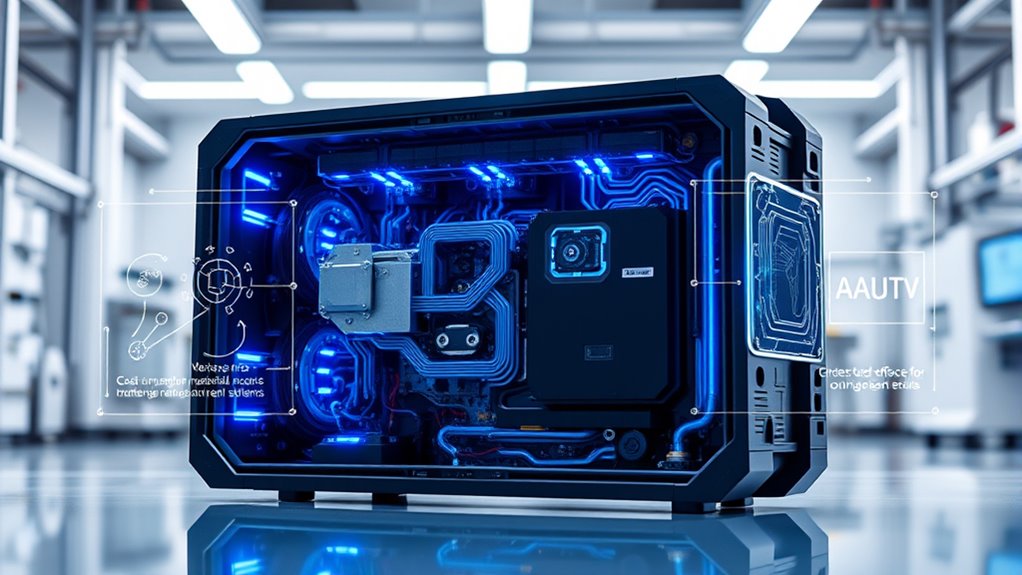
Recent advancements in fast-charging technologies and wireless power transfer are not only transforming how quickly you can recharge an electric vehicle but also opening new avenues to make batteries more affordable and durable. By adopting lithium iron phosphate (LFP) batteries and solid-state batteries, manufacturers reduce costs through abundant, low-cost materials. Innovative cell architectures like cell-to-pack and bipolar designs boost energy density, lowering material and assembly expenses while extending battery lifespan. Enhanced battery management systems optimize thermal regulation and charge cycles, minimizing degradation. Recycling technologies recover critical minerals from used batteries, cutting raw material costs and promoting sustainability. Faster charging techniques, such as ultra-fast charging and biological semiconductors, lessen stress on batteries, further extending lifespan and reducing replacement costs. These strategies collectively advance both affordability and longevity in EV batteries.
Visionary Concepts and Technologies Paving the Way Forward

You’re on the cusp of a revolution in EV battery technology, where next-generation chemistries like lithium-sulfur and graphene-enhanced cells are set to deliver higher energy and safety. Breakthrough architectures such as cell-to-pack and bipolar designs are making batteries more efficient and cost-effective. Meanwhile, sustainable materials are driving innovations that could reshape the future of electric mobility.
Next-Generation Chemistries
Next-generation battery chemistries are revolutionizing electric vehicle technology by offering higher energy densities, faster charging times, and lower costs. Solid-state batteries, with prototypes like Toyota’s 2028 model, aim for a 1200 km range and 10-minute fast charging by replacing liquid electrolytes with ceramics or polymers. Lithium-sulfur batteries leverage sulfur’s ability to host two lithium ions per atom, potentially doubling current EV range with high-energy-density benefits. Silicon anodes, capable of holding four lithium atoms per silicon atom, profoundly increase capacity, promising tenfold improvements over traditional graphite. Dual-ion batteries utilize both cations and anions, enabling rapid charging and higher voltages, though cycle life remains a challenge. These new battery technologies are paving the way for more efficient, longer-range electric vehicles.
Breakthrough Cell Architectures
Innovative cell architectures are transforming electric vehicle batteries by maximizing energy density, enhancing safety, and streamlining manufacturing. The cell-to-pack architecture eliminates modular packaging by integrating individual cells directly into the battery pack, boosting energy density by up to 15%. Bipolar designs stack cells with shared electrodes, reducing weight and enabling a 20% increase in driving range. Solid-state architectures replace liquid electrolytes with solid electrolytes, offering faster charging, improved safety, and higher energy density. Additionally, advanced geometries like pouch and cylindrical formats optimize cell-to-pack integration, simplifying manufacturing processes and improving overall performance. These breakthrough architectures pave the way for safer, more efficient, and higher-capacity batteries, bringing you closer to the next generation of electric vehicle technology.
Sustainable Material Innovations
As the demand for sustainable transportation grows, researchers are exploring alternative materials that can make electric vehicle batteries more eco-friendly. They’re developing batteries using sustainable materials like seawater-derived electrolytes, biodegradable electrodes, and recycled critical minerals to lower environmental impact. Using abundant elements such as sulfur, sodium, and iron creates cost-effective, eco-friendly batteries that reduce dependence on scarce minerals. Technologies like lithium-sulfur and sodium-ion batteries harness these resources, offering higher energy density with a smaller ecological footprint. Advances in recycling enable recovery and reuse of critical minerals, supporting a circular economy and minimizing waste. Novel electrode materials, like copper cellulose and bio-based composites, replace traditional components with sustainable, biodegradable options that maintain high performance, paving the way for greener, more sustainable EV batteries.
Frequently Asked Questions
What Is the Most Promising EV Battery Technology?
You might wonder which EV battery tech holds the most promise. Currently, solid-state batteries stand out because they offer higher energy density, faster charging, and better safety. Companies like Toyota aim to bring them to market by 2028. While other options like LFP, lithium-sulfur, or sodium-ion have advantages, solid-state batteries seem poised to revolutionize electric vehicles, making them more efficient and safer for future driving.
What Is the Latest Development in Battery Technology?
Imagine you’re riding a spaceship in 2050—beyond now’s tech. The latest development in battery tech is solid-state batteries, which major companies like Toyota are aiming to produce by 2027-2028. These batteries offer higher energy density, faster charging, and improved safety. Meanwhile, lithium-sulfur and silicon-anode advancements are pushing capacities even further, and ultrafast wireless charging is making quick recharges a reality, transforming EV convenience and performance.
What Will Replace Lithium in Battery Technology?
You wonder what could replace lithium in batteries. Researchers are exploring options like sodium-ion batteries, which use abundant sodium and offer similar energy density at lower costs. Lithium-sulfur batteries provide higher energy capacity with inexpensive sulfur. Solid-state batteries and alternatives like magnesium, calcium, and aluminum chemistries also show promise. These innovations aim to reduce reliance on lithium while maintaining or improving battery performance for future electric vehicles.
What Is the Holy Grail of Battery Technology?
They say, “dream big or go home,” and that’s exactly what the “holy grail” of battery tech aims for. You’re looking at batteries with over 500 Wh/kg, charging in under five minutes, lasting forever, and staying safe and affordable. Solid-state, lithium-sulfur, and lithium-metal batteries are leading contenders, using abundant materials and innovative designs to turn this ambitious goal into reality. It’s a quest to power the future sustainably.
Conclusion
Imagine holding a tiny seed that holds the future of transportation. Just like that seed, innovations in EV battery tech are sprouting new possibilities—faster charging, longer lifespan, greener materials. Each breakthrough is a drop of water nurturing this seed, helping it grow into a sustainable, powerful tree that can shade generations to come. Together, these advancements are transforming the landscape, turning the dream of clean, efficient mobility into a vibrant reality you can help cultivate.
